nn
n
n In between the chapter in which he describes thenunicorn and that in which he portrays the basilisk, Pliny the Elder describesnanother creature that is able to kill with a single glance, the catoblepas,nwhich takes its name from the Greek καταβλέπω –meaning ‘to lookndownwards’.
n
n
n
n“An animal of moderate size, and in other respects sluggishnin the movement of the rest of its limbs; its head is remarkably heavy, and itnonly carries it with the greatest difficulty, being always bent down towardsnthe earth. Were it not for this circumstance, it would prove the destruction ofnthe human race; for all who behold its eyes, fall dead upon the spot.”n
n(NaturalnHistory, Book 8, Chapter 32).n
n
n
nGeorges Cuvier, the great French naturalistnand zoologist, was of the opinion that Pliny was referring to a conflation ofndescriptions of the hippopotamus and the gnu, (Essay on the Theory of thenEarth), which seems sensible enough if we refer to the description of thencatoblepas in Edward Topsell’s The Historie of Foure-Footed Beastes (1607),
n
n
n
n“Among the manifold and divers sorts of Beasts which are bred in Affricke,nit is thought that the Gorgon is brought foorth in that countrey. It is anfeareful and terrible beast to behold: it hath high and thicke eie-lids, eiesnnot very great, but much like an Oxes or Bugils [Buffaloes], but allnfiery bloudy, which neyther looke directly forwarde, nor yet upwards, butncontinuallye downe to the earth, and therefore are called in GreekenCatobleponta.”n
n
n
n
n
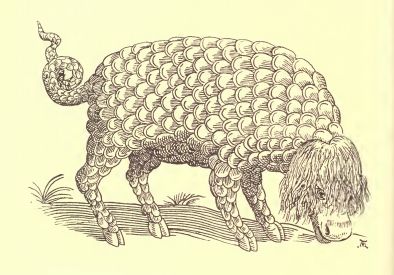 |
| Edward Topsell – Catoblepas |
n
n
n
nThe illustration that accompanies this description certainlynlooks like a strange hybrid of the hippopotamus and the wildebeest. Topsellngets himself into a terrible muddle when he describes the Gorgons who are, hensays, the daughters of Medusa and Phorcynis, and he has Perseus cutting off anmale Medusa’s head before he was placed in the constellation that bears hisnname. This male Medusa then becomes a female leader of an army of ferociousnAmazonian warriors, who lived in Africa, and was beheaded by Perseus and it wasnthe poets who then tacked on the story about her having snakes for hair.
n
n
n
 |
| Gorgon’s Head |
n
n
n
nThenGorgon creatures were poisonous and Topsell thought they killed men with theirnbaleful eyes rather than with their breath, and he tells the story of how thenRoman general Marius sent soldiers to kill a gorgon but they were all killed bynits gaze, so more soldiers were sent with orders to kill one with spears, fromna distance, which they did and its skin was sent to Rome, where it was placednin the Temple of Hercules. Topsell has got his wires crossed with the mythologynof the Gorgons, which may not be surprising as there are varying accounts ofntheir genesis.
n
n
n
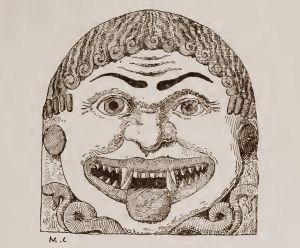 |
| Gorgon’s Head |
n
n
n
nIn the earliest legends, Gorgon was a single monstrous creaturenbut Hesiod changes to story and transforms Gorgon into three sisters, born ofnthe sea-deities Keto and Phorcys, two of which are immortal, Stheno andnEuryale, and the third is mortal, she is Medusa. The Gorgon – from the Greek Γοργώνn– ‘dreadful’ – had brazen hands, gold-coloured wings, teeth as long asnboars’ tusks and their eyes would turn any living thing to stone. Medusa alonenhad snakes for her hair, a punishment inflicted on her by Athena for allowingnherself to be ravished by Poseidon in Athene’s temple.
n
n
n
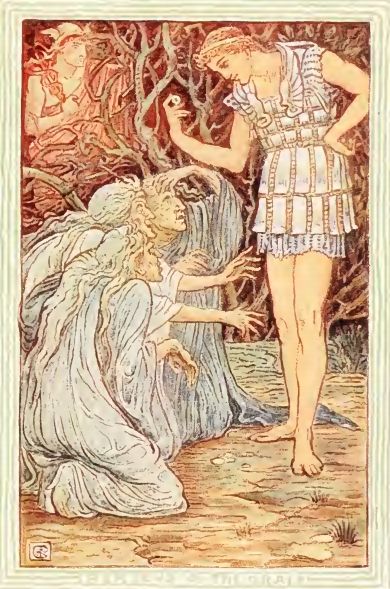 |
| Perseus and the Graeae |
n
n
n
nThe Gorgons were thensisters of the Graeae and later legends mix the two trios into a single one;nthe Graeae were also the offspring of Keto and Phorcys, they were threenancient, grey-haired sisters who shared between them a single eye and a singlentooth. Their names were Deino (Δεινώ – ‘dread’), Enyo (Ενυώ –n‘horror’) and Pemphredo (Πεμφρηδώ – ‘alarm’).
n
n
n
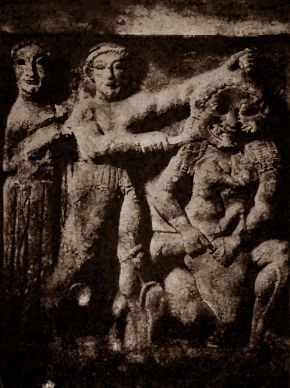 |
| Perseus and Medusa |
n
n
n
nKing Polydectes sentnPerseus to kill Medusa, in the hope that he would be turned to stone, but thenGods favoured Perseus and gave him gifts to assist his quest – a helmet ofninvisibility, winged sandals, a curved sickle-like sword, a mirrored shield andna bag in which to keep the Gorgon’s severed head.
n
n
n
 |
| Perseus is Given Gifts |
n
n
n
nHe visits the Graeae andnholds their common eye to ransom until they reveal the whereabouts of their Gorgonnsisters, and he flies on his winged sandals to end of the western world tonconfront them.
n
n
n
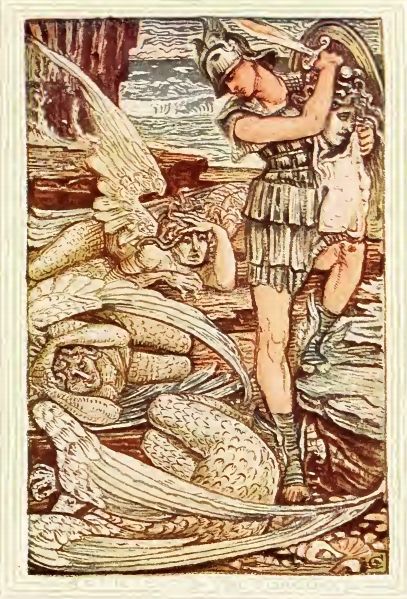 |
| Perseus kills Medusa |
n
n
n
nPerseus avoids Medusa’s direct gaze by looking at her reflectionnin the shield and succeeds in decapitating her, puts the head into the bag andnflies back Polydectes, whom he turns into stone by using the still-deadly head.
n
n
n
 |
| Perseus turning Polydectes to stone |
n
n
n
nAfter further adventures, Perseus gives the head to Athena, who places itneither on her shield or on her breastplate, the Aegis.
n
n
n
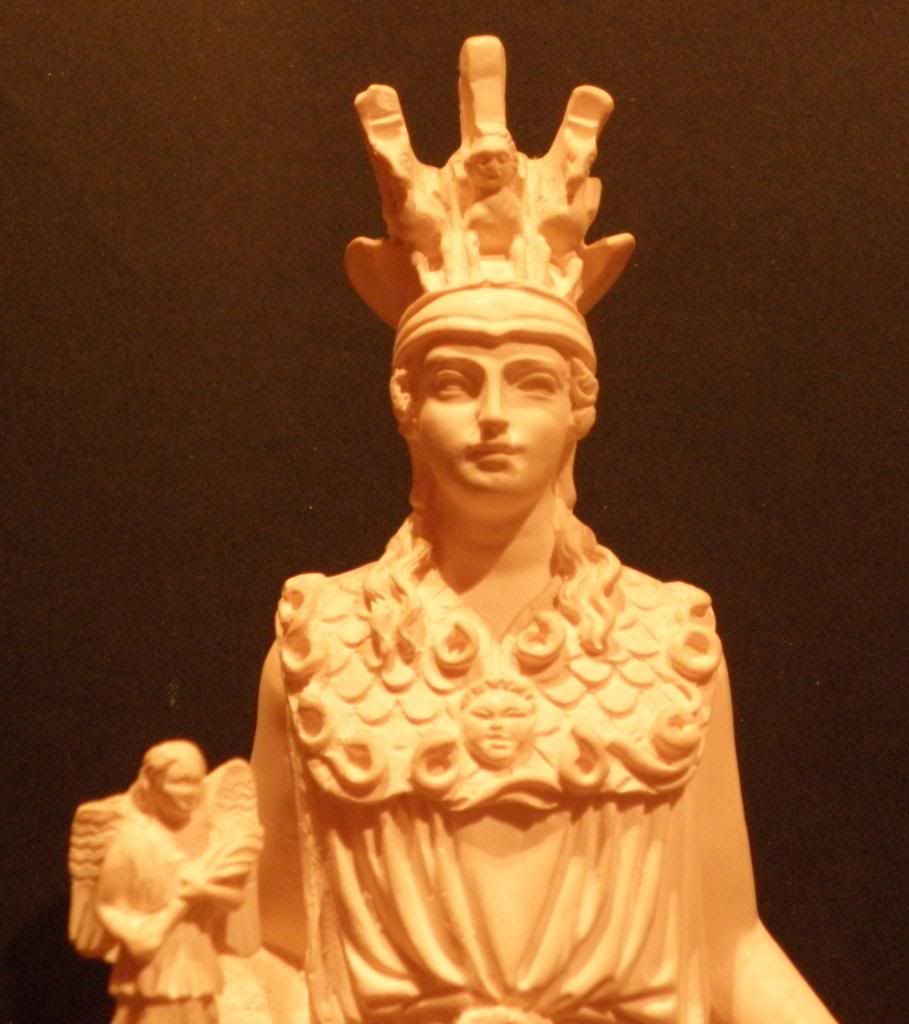 |
| Athena with Medusa’s head on her breastplace |
n
n
n
nThe drops ofnblood that dripped from Medusa’s neck either were turned into the venomousnsnakes of Africa or those that fell into the sea were turned into Pegasus, thenfabulous winged horse, and Chrysaor, the future king of Iberia.
n
n
n
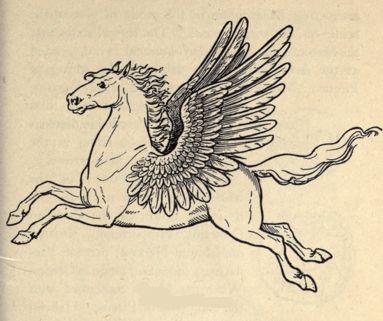 |
| Pegasus |
n
n
n
nPegasus wasnlater used by Bellerophon to conquer another fearsome mythological creature,nthe Chimera. This beast was born from the mating of Typhon and Echidna (the ‘Mothernof all Monsters’ and another horror courtesy of the aforementioned seandeities Keto and Phorcys), and was a fire-breathing hybrid with the body of anlion, the head of a goat sprouting from its back, and a tail ending with anserpent’s head (the word ‘chimera’ has since come to mean any monstrousnhybrid creature, particularly those that are the creation of crazedngenetic-scientists who beaver away in secret laboratories located insidenvolcanoes).
n
n
n
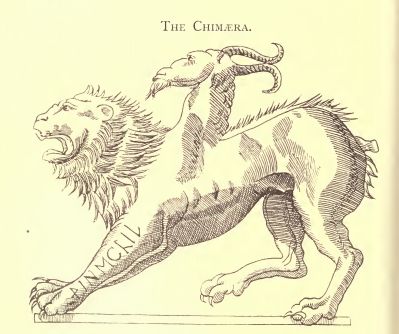 |
| Chimera |
n
n
n
nIt is thought that the chimera is an explanation of the phenomenanof the permanent methane gas vents that burn on Mount Olympos, Lycia and wasnreputed to have lions living on its summit, goats grazed on its lower pasturesnand there were serpents living around the base. King Iobates (mentioned here)nsent the youth Bellerophon on a series of seemingly impossible tasks, in thenhope he would be killed (spot the common theme, when it comes to getting rid ofnbothersome youths in ancient times), one of which was to defeat the chimera.nAthena gave Bellerophon a magic halter, with which he captured the winged horsenPegasus, allowing him to attack the monster from the air and thereby avoid itsnheads and its fiery breath.
n
n
n
 |
| Bellerophon slays the Chimera |
n
n
n
nHowever, the fame of his deed went to Bellerophon’snhead and he began to think that he ought to be living on Mount Olympus with thenGods, and mounted Pegasus with the intent of flying there. Zeus, irked by thisnpresumption, sent a gadfly to bite Pegasus on the rump, causing him to buck andnthrow Bellerophon off, who fell to earth and landed in a thorn bush, living outnthe rest of his miserable days as a blinded cripple. Hubris is a dreadfulnthing.
nnn
n
n
nnn
